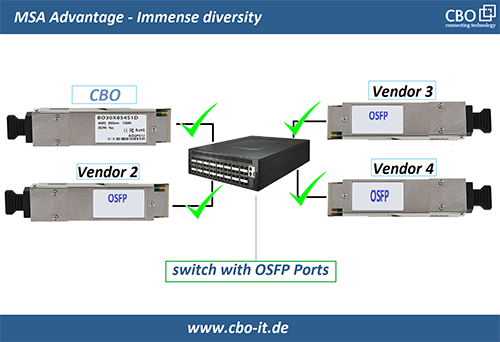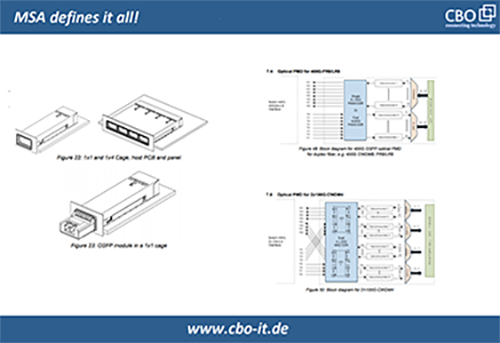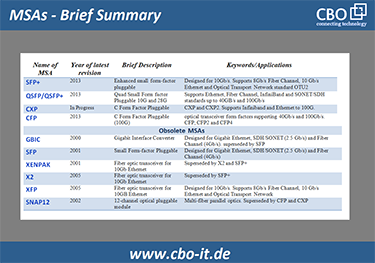
Work with transceivers such as QSFP-DD, QSFP28, SFP, etc. is a routine thing for data center engineers and technicians.
Do you know about the governing bodies that have a mandate to define these modules or to provide the industry with standard specifications for different kinds of transceivers?
Here comes the role of MSA standard and we are going to talk about it in the following parts of this article. So, stay tuned as there is plenty of useful information ahead.
What is MSA?
Almost everyone is familiar with the term “MSA compliant” as it is often found written in the protocol section of the specifications of different optical transceivers. MSA refers to an industry-wide agreement called a multi-source agreement. Multi-Source Agreements are specifications and guidelines established by different vendors who cooperate to standardize the fit, function, and form of new devices.
Today, we have MSAs available for various kinds of devices including (but not limited to); passive copper modules, connector interfaces, and active optical modules. So, any product designed under a certain multi-source agreement by various vendors should come with similar design features.

Are Multi-source Agreements (MSAs) Official?
No! MSAs are not recognized standards as the international bodies don’t recognize the multi-source agreement. As we have mentioned above, MSAs are defined and agreed by a group of participating vendors or signatories. The IEEE (Institute of Electrical and Electronics Engineers) is the only official body working on the development of new standards for transceivers.
What resulted in the formation of MSAs?
The formation of multi-source agreements became inevitable when different equipment manufacturers started designing and developing their transceivers and other equipment. This resulted in poor interoperability and interchangeability. At that point in time, multi-source agreements were proposed and collaborative efforts initiated. Now, an SFP+ transceiver designed by a vendor can be replaced with an SFP+ transceiver designed by another vendor.
What comes under MSAs Scope?
Multi-source agreements or MSAs offer very detailed guidelines about the construction, operations, mechanical and electrical aspects of the module or device under considerations. Following are a few major elements which are defined by MSAs generally;
- Dimensions of the device
- Extraction, insertion and retention forces
- Labeling
- Host system design
- Cage assembly dimensions
- Timing requirements
- Pin definitions
- Operating parameters
- Etc.
Why is MSAs Crucial?
MSAs are important because they guarantee that the products built under these multi-source agreements will exhibit total compliance to the host systems. Moreover, the products develop under MSAs remain interchangeable and interoperable. Following are a few points which furnish the importance of MSAs;
MSA standards provide the end-users with an almost unlimited choice as MSA compliant modules come with the same characteristics and form factor. In short, customers can go with a vendor of their choice as long as the modules they are purchasing are MSA compliant.
MSA standards are a great tool to promote competition in the market and to seize any kind of monopolization. Now, even less popular and mediocre vendors can develop their products to compete with comparatively bigger manufacturers. In this scenario, effective cost controlling can also be achieved.
MSA standards are a great source of security for the manufacturers of switches and routers because transceivers developed under MSAs come with similar form-factors. Thus, the ports intended to host these transceivers also remain compliant with hardware regardless of its manufacturer.
A Brief Summary of Existing and Obsolete MSAs
Multi-source agreements once agreed are published for the general public. However, the process of MSAs revision, enhancement, and rectification is a continuous one. Here, it is important to understand that a revised MSA does not nullify previous revisions or the original standard. It is ensured that each new revision of multi-source agreements should remain backward compatible. Following is a summary of some useful information regarding different MSAs including a few that are obsolete by now!

Conclusion
MSAs or multi-source agreements are a great way to govern hardware development within the networking industry. These agreements allow the development of interoperable and interchangeable hardware – a great thing for customers and vendors. Today, you can purchase an optical transceiver to replace one of your faulty transceivers from any vendor of your choice with a peace of mind. Even today, different groups and committees are working on newer projects and thus we can anticipate many more great products ahead.
 English
English
 Deutsch
Deutsch
 Espaniol
Espaniol










